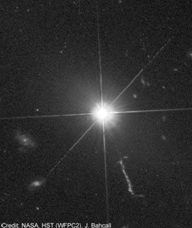- 1610: Galileo
- 1676: Ole Rømer
- 1687: Isaac Newton
- 1781: William Herschel
- 1838: Friedrich Bessel
- 1861: William and Margaret Huggins
- 1912: Henrietta Leavitt
- 1917 Einstein
- 1920: Harlow Shapley
- 1929 Edwin Hubble
- 1948: Ralph Alpher
- 1949: Fred Hoyle
- 1963: Maarten Schmidt
- 1964: Arno Penzias and Robert Wilson
- 1978: Vera Rubin and Kent Ford
- 1989: Margaret Geller and John Huchra
- 1992: John Mather and George Smoot
- 1995: Robert Williams
- 1998: Saul Perlmutter and Brian Schmidt
- 2010: Wendy Freedman
Quasar
 At right is an image of Quasar 3C 273, which is the first of its class detected by Maarten Schmidt. Other quasars have since been discovered. As Schmidt suspected, these objects are extremely bright and very far from our own Milky Way. In 1978 the term “Blazars,” was used to classify these objects which now known to be located at the center of giant elliptical galaxies, and powered by a supermassive black hole. Blazars are very compact, and vary in brightness as they absorb the mass of stars that fall into the black hole. Many of these have visible plasma jets streaming away from the Blazar at speeds close to the speed of light. 3C 273 has such a jet, visible to the lower right in this image. Blazars are considered to be one type of Active Galactic Nuclei.
At right is an image of Quasar 3C 273, which is the first of its class detected by Maarten Schmidt. Other quasars have since been discovered. As Schmidt suspected, these objects are extremely bright and very far from our own Milky Way. In 1978 the term “Blazars,” was used to classify these objects which now known to be located at the center of giant elliptical galaxies, and powered by a supermassive black hole. Blazars are very compact, and vary in brightness as they absorb the mass of stars that fall into the black hole. Many of these have visible plasma jets streaming away from the Blazar at speeds close to the speed of light. 3C 273 has such a jet, visible to the lower right in this image. Blazars are considered to be one type of Active Galactic Nuclei.
Thanks to the Sloan Digital Sky Survey, 120,000 quasars have now been discovered and mapped.